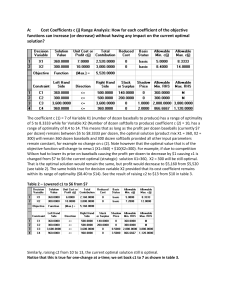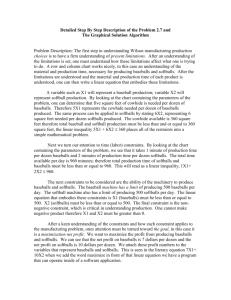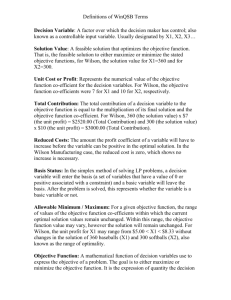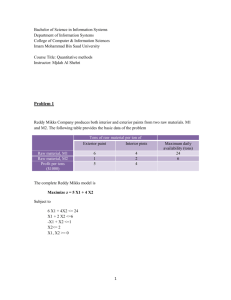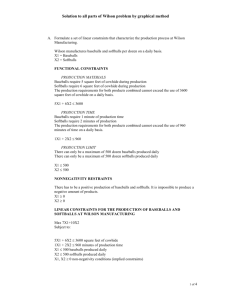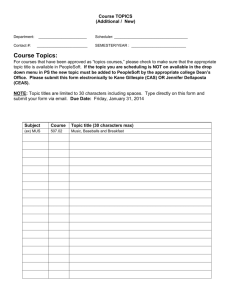An Almost Complete Solution with Sensitivity Analysis to the Wilson
advertisement
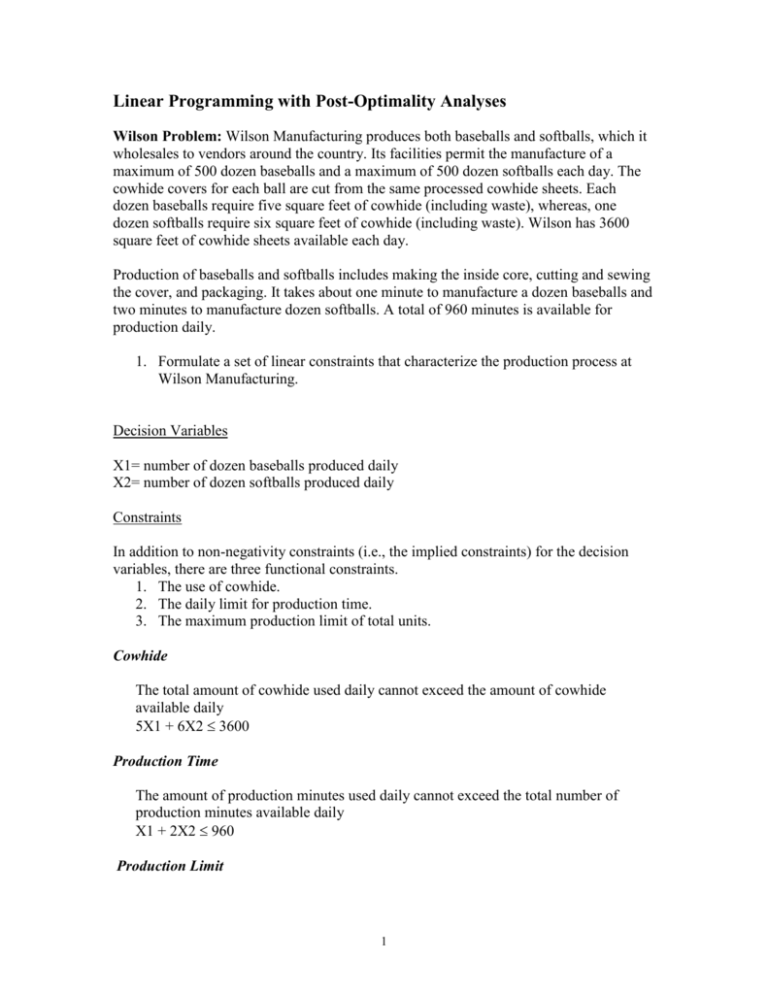
Linear Programming with Post-Optimality Analyses Wilson Problem: Wilson Manufacturing produces both baseballs and softballs, which it wholesales to vendors around the country. Its facilities permit the manufacture of a maximum of 500 dozen baseballs and a maximum of 500 dozen softballs each day. The cowhide covers for each ball are cut from the same processed cowhide sheets. Each dozen baseballs require five square feet of cowhide (including waste), whereas, one dozen softballs require six square feet of cowhide (including waste). Wilson has 3600 square feet of cowhide sheets available each day. Production of baseballs and softballs includes making the inside core, cutting and sewing the cover, and packaging. It takes about one minute to manufacture a dozen baseballs and two minutes to manufacture dozen softballs. A total of 960 minutes is available for production daily. 1. Formulate a set of linear constraints that characterize the production process at Wilson Manufacturing. Decision Variables X1= number of dozen baseballs produced daily X2= number of dozen softballs produced daily Constraints In addition to non-negativity constraints (i.e., the implied constraints) for the decision variables, there are three functional constraints. 1. The use of cowhide. 2. The daily limit for production time. 3. The maximum production limit of total units. Cowhide The total amount of cowhide used daily cannot exceed the amount of cowhide available daily 5X1 + 6X2 3600 Production Time The amount of production minutes used daily cannot exceed the total number of production minutes available daily X1 + 2X2 960 Production Limit 1 The total number of dozen units produced daily cannot exceed the marketing limits X1 500 X2 500 Non-negativity of Decision Variables Negative Production of baseballs and softballs is impossible. Thus, X1, X2 0 The Mathematical Model Max 7X1+ 10X2 (Objective Function) Subject to: 5X1 + 6X2 3600 (Cowhide) X1 + 2X2 960 (Production time) X1 500 (Production limit of baseballs) X2 500 (Production limit of softballs) X1, X2 0 (Non-negativity) 2 Detailed Step By Step Description of the Problem and The Graphical Solution Algorithm Problem Description: The first step in understanding Wilson manufacturing production choices is to have a firm understanding of present limitations. After an understanding of the limitations is set, one must understand how these limitations affect what one is trying to optimize. A row and column chart works nicely; in this case an understanding of the material and production time, necessary for producing baseballs and softballs. After the limitations are understood and the material and production time of each product is understood, one can then write a linear equation that embodies these limitations. A variable such as X1 will represent a baseball production; variable X2 will represent softball production. By looking at the chart containing the parameters of the problem, one can determine that five square feet of cowhide is needed per dozen of baseballs. Therefore 5X1 represents the cowhide needed per dozen of baseballs produced. The same process can be applied to softballs by stating 6X2, representing 6 square feet needed per dozen softballs produced. The cowhide available is 360 square feet therefore total baseball and softball production must be less than and or equal to 360 square feet, the linear inequality 5X1 + 6X2 360 places all of these conditions into a simple mathematical problem. Next we turn our attention to time (labor) constraints. By looking at the chart containing the parameters of the problem, we see that it takes 1 minute of production time per dozen baseballs and 2 minutes of production time per dozen softballs. The total time available per day is 960 minutes; therefore total production time of softballs and baseballs must be less than or equal to 960. This will read as a linear equation, 1X1+ 2X2 960. The next constraints to be considered are the ability of the machinery to produce baseballs and softballs. The baseball machine has a limit of producing 500 baseballs per day. The softball machine also has a limit of producing 500 softballs per day. The linear equation that embodies these constraints is X1 (baseballs) must be less than or equal to 500. X2 (softballs) must be less than or equal to 500. The final constraint is the nonnegative constraint, which is critical in understanding production. One cannot make negative product therefore X1 and X2 must be greater than 0. After a keen understanding of the constraints and how each constraint applies to the manufacturing problem, ones attention must be turned toward the goal, in this case it is a maximization net profit. We want to maximize the profit from producing baseballs and softballs. We can see that the net profit on baseballs is 7 dollars per dozen and the net profit on softballs is 10 dollars per dozen. We attach these profit numbers to the variables that represent baseballs and softballs. This is seen in the literary equation 7X1+ 10X2 when we add the word maximize in front of that linear equation we have a program that can operate inside of a software application. 3 Next we turn our attention to making a graph (i.e., the feasible region) of the production problem. The horizontal axis represents baseballs and the vertical axis represents softballs. A vertical line should be drawn that bisects the 500 number mark on the Xaxis; this line represents the maximum number of baseballs that can be produced. The horizontal line should be drawn that bisects the 500 mark on the Y-axis this represents the maximum number of softballs that can be produced. Next we graph the time constraint which is determined by drawing a point on the X-axis that represent the case that all the time were spent just making baseballs. Total time available is 960 so the point is at point 960. The Y-axis, which represents the time necessary to make softballs, the point would be at 480. When a line is then drawn across the graph plain, this line will represent the time constraint. Finally we have to draw the cowhide restraint. This is determined by finding the point in the X-axis that represents the case if all the cowhide were used on baseballs. This point is 720. Now we draw a line on the Y-axis that represents, if all of the cowhide were used on softballs. This number is 600 we connect those two dots with a line to the graph plain. Because the cowhide restraint must be less than 3600, all the area to the right of the cowhide constraint line will not be included in the solution. Because the time constraint is equal to or less than 960 all the area above the time constraint line will not be included in the solution. Because the limit of 500 placed on baseballs all the area to the right of the baseball constraint line will not be included in the solution. Because the constraint of 500 is placed on softballs, all the area above the softball constraint line is excluded from the solution. When all of these lines are placed on a graph and the areas that are excluded are removed, including the negative areas, the area that is left is called the feasible region. Any corner point of the feasible region can be accomplished under present constraints. In order to maximize profits, a point where two of the line constraints bisect must be chosen. There are four such points in our problems. After subtracting linear equation from linear equation the best point of manufacturing is where the cowhide constraint and the time constraint bisect, this point would be producing 360 baseballs and 300 softballs. As we know, a Formulation of the Wilson Manufacturing problem is: X1 = the number of dozen baseballs manufactured daily X2 = the number of dozen softballs manufactured daily. Max Objective Function 7X1+10X2 Subject to: C1 = X1 500 C2 = X2 500 C3 = 5X1 + 6X2 3600 C4 = X1 + 2X2 960 C5 = Xj 0; j = 1, 2 (constraint of production) (constraint of production) (this is the constraint of the material) (the constraint of the production time available) (non negativity) 4 a. Graph the feasible region for this problem (Hand computation is submitted separately). C4 relegates the solution to quadrant I. X1 and X2 must be positive numbers (or 0). Wilson is considering manufacturing 300 dozen baseballs and 300 dozen softballs. Applying the constraints: C1; X1 < 500; 300 < 500. Constraint is satisfied. C2: X2 < 500; 300 < 500. Constraint is satisfied. C3; 5X1 + 6X2 < 3600; 5(300) + 6(300) =3300<3600. Constraint is satisfied. C4; X1 + 2X2 < 960; 300 +2(300) = 900 < 960. Constraint is satisfied. Since the constraints are satisfied, the solution of 300 dozen each is an interior point located within the feasible area. Wilson considers manufacturing 350 dozen baseballs and 350 dozen softballs. Again, applying the constraints: C1; X1 500; 350 < 500. C2; X2 500; 350 < 500. C3; 5X1 + 6X2 3600; 5(350) +6(350) = 3850 > 3600. C4; X1 + 2X2 960; 350 + 2(350) = 1050 > 960. 5 Constraint is satisfied. Constraint is satisfied. Constraint is not satisfied. Constraint is not satisfied. Wilson does not have enough materials or the time necessary to manufacture according to this objective. Constraints C3 and C4 are infeasible points. Fore any interior point there is always some distance from the constraints which is proportional to slack for and surplus for ≥ constraints (making RHS value nonnegative) that prohibits the optimal solution until it has been removed. The second solution lies outside the feasibility region and therefore is not possible under the constraints imposed. b. Wilson estimates that its profit is $7.00 per dozen baseballs and $10.00 per dozen softballs, the production schedule that maximizes their daily profit is found at the extreme point, (360, and 300). 7(360) + 10(300) = 5,520. c. C1; X1 500 is a non-binding constraint C2: X2 500 does not eliminate any points from consideration. It is redundant. C3; 5X1 + 6X2 3600 is a binding constraint. C4; X1 +2X2 960 is a binding constraint. C5; Xj 0, j = 1, 2, are non-binding. 6 How Things Can Go Wrong In The Graphical Method: 1. Formulation of the problem is wrong. 2. The boundary lines of the feasible region should be the constraints at their binding (=) position NOT , or . 3. Ignored or missed some constraints in the solution algorithms. 4. The computer output report is being handed in without any managerial explanations. I do not need any printout without explanation. You as a Management Scientist should never submit a print out to the Manager (i.e., decision maker) without enough explanation of what those numbers mean in simple the language (no keywords or phrases) understandable the manager. That is, the same language and style the problem was described in words. 5. Getting the solution from the computer package and then found the optimal point by solving one system of equations. The correct graphical approach as outlined in your lecture note is as follow: since the feasible region is bounded, then solution is one of the vertices. Which vertex is the optimal? You need to find the coordinate of all feasible corner point; then evaluate the objective function, then to see which one provides the maximum value. This way we determine the optimal strategy and then the optimal value. 6. To have a unified standard for presenting graphical solution, it is customary (as in your textbook, and your lecture notes) to have X1, and X2 as the horizontal and vertical axis, respectively (not the other way round). Unfortunately, some ignore this practice. 7 Algebraic Solution Algorithm The Mathematical Model 5X1 + 6X2 3600 (Cowhide) X1 + 2X2 960 (Production time) X1 500 (Production limit of baseballs) X2 500 (Production limit of softballs) X1, X2 0 (Non-negativity conditions) Algebraic Method: Consider all constraints at binding (i.e., all with = sign) position: 5X1 + 6X2 = 3600 X1 + 2X2 = 960 X1 = 500 X2 = 500 X1 = 0 X2 = 0 Here we have 6 equations with 2 unknowns. In terms of a "binomial coefficient", there are at most 6! / [2! (6-2)!] = 15 basic solutions. Solve each pair of systems of equations, (for this problem, we are able to get only 13 solutions). Check each solution against the constraints for feasibility. Five of the above basic solutions are basic feasible solutions satisfying all the constraints, belonging to the coordinates of the vertices of the feasible region. By plugging in the basic feasible solution in the objective function, we compute the optimal value X1 X2 Feasible? 500 500 no 500 183.3 yes 500 230 no Impossible no 500 0 yes 120 500 no -40 500 no 0 500 no 0 Impossible 360 300 yes 0 600 no 720 0 no 0 480 yes 960 0 no 0 0 yes Objective Function 7X1+10X2 5333 - (due to the fact that the two lines are parallel) 3500 - (due to the fact that the two lines are parallel) 5520 Optimal Value 4800 0 8 Therefore, from the above table, we see that, the optimal solution is X1 = 360, X2 = 300, with optimal value of $5520. The above approach can be applied in solving higher dimension LP problems. This is what essentially all LP packages do in a more efficient way call the Simplex Method. Dual Problem and Its Meaning The Dual Analysis involves looking at a situation from a different perspective. For example, a maximization problem would become a minimization one. The Dual Analysis allows an analyst to see the other side of a situation. In Wilson Manufacturing’s case, they wanted to maximize their profits (7X1+10X2) while staying within their respective constraints. The optimal value was calculated to be (360, 300) yielding a profit of $5,520. We can now turn the situation around and look at it as a minimization problem as well by looking at its dual. The original maximization equation/problem is known as the Primal. To calculate the Dual problem, the number of variables is calculated by looking at the number of constraints of the Primal. Since we have 4 constraints, the Dual will have 4 variables. Now the coefficients of the Dual will come from the right hand side of the constraints of the Primal. The Dual also has some constraints. The number of constraints is determined by the number the number of variables of the Primal. Since the Primal has 2 variables, the Dual will have 2 constraints. The coefficients of the Dual come from the coefficients of the constraints from the Primal. The only thing to remember is that the row of coefficients of the Primal becomes the column of coefficients of the Dual. Now the right hand side of the constraints comes from the coefficients of the maximization equation of the Primal. Refer to the following equations to represent the transformation of the problem from maximization to minimization. Maximization 7X1+10X2=5520 Minimization 3600U1+960U2+500U3+500U4 Constraints Constraints X1≤500 5U1+1U2+U3≥7 X2≤500 6U1+2U2+U4≥10 5X1+6X2≤3600 Uj≥0 j=1, 2, 3, 4 1X1+2X2≤960 9 Variable U1 U2 U3 U4 Direction Minimize 3600 960 500 500 Cowhide 5 1 1 >= Time 6 2 1 >= Lower Bound 0 0 0 0 Upper Bound M M M M Variable Type Continuou Continuou Continuo Continuo s s us us Decision Variable 1 U1 2 U2 3 U3 4 U4 Objective Constrai nt 1 Baseball 2 Softball RHS 7 10 Solution Unit Cost Total Reduce Basis Allowabl Allowabl Value Contributi d Cost Status e Min. e Max. on c(j) c(j) 1 3,600.00 3,600.00 0 basic 2,880.0 3,880.0 0 0 2 960 1,920.00 0 basic 866.666 1,120.0 7 0 0 500 0 140 at 360 M bound 0 500 0 200 at 300 M bound Function (Min.) = 5,520.00 LHS Direction RHS 7 10 >= >= 7 10 Surplus Shadow Allowabl Allowable Price e Min. Max. RHS RHS 0 360 5 8.3333 0 300 8.4 14 As you can see, the Primal and Dual are directly related to each other. In both cases, the optimal value is the same, which is always going to be the case. There are so many similarities that can be seen in both of the calculations showing how they are related to each other. For example, the shadow prices in the maximization model represent the solution values in the minimization model. The information pertaining to the maximum and minimum values for the object of the coefficient and 10 RHS are switched between models as well. For the most part, the problems are exactly the same except everything has switched places and that is because you are searching for the exact opposite answer, meaning maximization versus minimization. The solutions were calculated as U1=1 and U2=2 with the optimal value being $5520. 11 Computer Implementation Decision Variable: A factor over which the decision maker has control; also known as a controllable input variable. Usually designated by X1, X2, X3… Solution Value: A feasible solution that optimizes the objective function. That is, the feasible solution to either maximize or minimize the stated objective functions. For Wilson, the optimal solution value is for X1=360 and for X2=300. Unit Cost or Profit: Represents the numerical value of the objective function co-efficient for the decision variables. For Wilson, the objective function coefficients were 7 for X1 and 10 for X2, respectively. Total Contribution: The total contribution of a decision variable to the objective function is equal to the multiplication of its final solution and the objective function coefficient. For Wilson, 360 (the solution value) x $7 (the unit profit) = $2520.00 (Total Contribution) and 300 (the solution value) x $10 (the unit profit) = $3000.00 (Total Contribution). Reduced Costs: The amount the profit coefficient of a variable will have to increase before the variable can be positive in the optimal solution. In the Wilson Manufacturing case, the reduced cost is zero, which shows no increase is necessary. Basis Status: In the simplex method of solving LP problems, a decision variable will enter the basis (a set of variables that have a value of 0 or positive associated with a constraint) and a basic variable will leave the basis. After the problem is solved, this represents whether the variable is a basic variable or not. Allowable Minimum / Maximum: For a given objective function, the range of values of the objective function coefficients within which the current optimal solution values 12 remain unchanged. Within this range, the objective function value may vary, however the solution will remain unchanged. For Wilson, the unit profit for X1 may range from $5.00 < X1 < $8.33 without changes in the solution of 360 baseballs (X1) and 300 softballs (X2), also known as the range of optimality. Objective Function: A mathematical function of decision variables use to express the objective of a problem. The goal is to either maximize or minimize the objective function. It is the expression of quantity the decision maker wishes to optimize. The objective function (max) is obtained by adding the total contributions of the decision variables. For Wilson, $2,520.00 + $3,000.00 = $5,520.00 Constraint: A restrictive condition that may affect the optimal value for an objective function. Left Hand Side: After the problem is solved, the left hand side value of a constraint is equal to the sum of the decision variable value times it co-efficient in the constraint. For example, constraint (C1) for Wilson Manufacturing was 5X1 + 6X2 < 3600. After the problem was solved, 5(360) + 6(300) = 3600; 3600=3600. Direction: Indicates the relationship that exists between the RHS and the LHS of the linear problem. Right Hand Side: The right hand side of a constraint usually represents a constant value that represents the maximum (<, =) or minimum (>) requirement. Slack: The amount of a resource that is left over when the value of the left hand side of the constraint is subtracted from the constant on the right hand side of the constraint. Associated with the “<” constraints. For Wilson, there is “0” slack. Surplus: The amount by which some minimum restriction is exceeded at a given point when the constant on the right hand side is subtracted for the value of the left hand side. Associated with “>” constraints. For Wilson, there is “0” surplus. Shadow Price: The change to the optimal value of the objective function results from one unit increase in the right hand side of a constraint, therefore the shadow price is also the solution values for the dual. For example, if Wilson Manufacturing suddenly had 3601 feet of cowhide available the objective function value would increase by $1 (the shadow price) to $5,521.00. Similarly, if Wilson suddenly had 1 additional minute of production time, the objective function values would increase by $2 ($5,522.00). Allowable Minimum / Maximum RHS: The set of right hand side values of a resource over which the shadow prices do not change. It is also known as the range of feasibility because over this range of values, the solution to the current set of binding constraint equations is a feasible solution. Note: the values of the variables in the optimal solution and the objective function values change; it is the shadow prices that do not change. For example, Wilson Manufacturing may use 2881 to 3879 feet of cowhide to produce its baseballs and softballs and the shadow price will remain $1 for a one-unit increase. 13 As you can see from the table, there are 2 decision variables and the optimal value of this problem is $7 (360) + $10 (300) = $5520 which is stated as Objective function under the column of total contribution. Allowable min and Allowable max columns give us the range of the optimality for the variables, which are baseballs and softballs in this case. The optimal solution will remain unchanged as long as the profit per dozen baseballs lies between $5.00 and $8.33 and as the profit per dozen softballs lies between $8.40 and $14.00. The slack/surplus variable values for the final solution are found in the `SLACK OR SURPLUS' column. The related shadow prices are found to the right of this. The slack variable is the variable added to the left-hand side of a less than or equal to (<=) constraint to convert the constraint into an equality. It can be interpreted as the unused resource or right-hand side. The surplus variable is the variable subtracted from the lefthand side of a greater than or equal to (>=) constraint to convert the constraint into an equality. It can be interpreted as the amount over the requirement or right-hand side. In this case we can see from the table that both of the values are slack values which means that there are 140 dozen unused baseballs and 200 dozen unused softballs. The shadow price of a constraint is the marginal change of the objective function when the right-hand side value of that constraint increases by one unit, i.e., values for which the RHS value can change while maintaining the validity of shadow prices. For the Constraint 1, which is material constraint in this case, the shadow price is $1.00. It basically means that if the right-hand site value of material constraint increases by one unit, objective function value changes by $1.00. For the Constraint 2, which is production time constraint in this case, the shadow price is $2.00. It basically means that if the righthand site value of production time constraint increases by one unit, objective function value changes by $2.00. The shadow price is 0 for constraint 3 (production of baseballs) and constraint 4 (production of softballs). The range of feasibility is determined by looking at the Allowable Min. and Allowable Max range of the constraints. For the material constraint, the range of feasibility is 2,880 to 3,880. They can produce 280 more cowhide sheets. The range of feasibility of the time constraint is 866,66 to 1,120. They can use 160 min, which is 2 hours and 40 min more for production. For the production limit constraints the range of feasibility are 360 to infinite. The Dual Problem Construction 14 In Dual format, if the primal is max, the dual should be minimization. Therefore, as we can see from the table it’s minimization. The right hand side should be the cost coefficient for dual and also we see that the signs change to the opposite direction. Minimize 3600 U1 + 960 U2 + 500 U3 + 500 U4 Subject To 5 U1 + 1 U2 + 1 U3 >= 7 6 U1 + 2 U2 + 1 U4 >= 10 Becomes a row for primal!!! All variables are non-negative. 15 Controlling the Problem Apply the right-hand-side (RHS) value and coefficients of the objective function coefficients sensitivity range to Wilson problem (computer implementation together with managerial interpretations of the computer solution). Using WinQSB, we arrive at the following solution of this Linear Problem: Using this information, we quickly see the ranges of the cost coefficients that will not change to optimal solution. Wilson’s profit on baseballs can vary between $5 and $8.33, and its profit on softballs can vary between $8.40 and 14, while still the current optimal strategy remains optimal. Notice that the optimal value may change for any change in the coefficients of objective function. We can also conclude from this information that as long as the amount of cowhide remains between 2880 sq. ft. and 3880 sq. ft., a one unit increase or decrease in the amount of cowhide available will only increase or decrease the profit by $1. Similarly, as long as the amount of production time ranges between 866.67 and 1120 minutes, any increase or decrease of production time of 1 minute will increase or decrease the optimal profit by $2. Construct the dual problem, solve it and then provide economical interpretations for the dual and its solution. The dual of this problem is as follows: MINIMIZE: 3600U1 + 960U2 + 500U3 + 500U4 SUCH THAT: 5U1 + U2 + U3 7 6U1 + 2U2 + U4 10 U1, U2, U3, U4 0 16 Using WinQSB, we arrive at the following dual solution of this Linear Problem: The dual problem tells us that Wilson will lose 5 sq. ft. worth of cowhide, 1 minute of production time for each dozen baseballs not produced, and 6 sq. ft. of cowhide, along with 2 minutes of production time for each dozen of softballs not produced. Notice that the optimal solution to one problem is the shadow price for the other problem and vice versa. The sensitivity ranges for the RHS of one problem is the same as sensitivity ranges for the coefficient of objective function for the other problem, and vice versa. Therefore, when the manager solves one problem he/she gets enough information for the other problem. This is why the report in WinQSB is called “A combined Report”. Sensitivity Analysis Cost Coefficients Sensitivity Analysis The optimal solution for Wilson Manufacturing was determined to be 360 baseballs and 300 softballs. By producing the aforementioned amounts of each product, Wilson Manufacturing was able to maximize its profits at $5,520. Now that the production has been determined, the next step is to see how sensitive the coefficients of the objective function are and what kind of effect they have on the optimal point. Sensitivity Analysis basically formulates a range of values that the coefficients of the objective function can take that will not have an effect on the optimal solution. However even though the optimal solution is not affected, the optimal objective function value will change as the coefficient increases or decreases. There are a couple of different methods that can be used to carry out the sensitivity analysis. One method has to do with using a linear programming model (for example QSB), shown below, to calculate the range by 17 entering the information into the program and calculating the results. The other one has to do with randomly changing the coefficient of the objective function and manually graphing the solution to analyze the effect of the change in the coefficient. 1 2 1 2 3 4 Decision Solution Unit Cost Total Reduced Basis Allowabl Allowabl or e e Variable Value Profit c(j) Contributi Cost Status Min. c(j) Max. c(j) on X1 360 7 2,520.00 0 basic 5 8.3333 X2 300 10 3,000.00 0 basic 8.4 14 Objectiv Functio (Max.) = 5,520.00 e n Left Right Slack Shado Allowabl Allowabl Hand Hand w e e Constrai Side Direction Side or Price Min. Max. nt Surplus RHS RHS C1 3,600.0 <= 3,600.00 0 1 2,880.0 3,880.00 0 0 C2 960 <= 960 0 2 866.666 1,120.00 7 C3 360 <= 500 140 0 360 M C4 300 <= 500 200 0 300 M The chart above gives the range of numbers that each coefficient can be without the optimal solution changing. The range of the baseballs is between 5 and 8.3333 while the range for the softballs is between 8.4 and 14. Using this method is good because it allows the values to be sketched and seen visibly. The only problem is that the value may not always be nice and round. For example, the high end for X1 or baseballs is 8.3333. This number makes it difficult to graph and figure out by just changing the value of the coefficient because it is not that often that 8.3333 will be chosen before 8 or 8.5. The same thing happened with X2 or softballs. Its low end was 8.4. Right Hand Side Sensitivity Analysis Now that the sensitivity of the coefficients has been determined, the right hand side of the binding constraints must be analyzed. The RHS analysis deals with the effect of a single unit change of the total number of a binding constraint on the optimal value, or profits because they are one in the same. The single unit change is otherwise known as the shadow price. For Wilson Manufacturing, referring to the table above it is clear that its first binding constraint, 5X1+6X2 ≤3600, has a 1 unit shadow price. The shadow price will remain the same as long as the constraint (cowhide) stays within the boundaries of 2,880 and 3,880. For the second constraint, 1X1+5X2 ≤960, there is a shadow price of 2. The shadow price will stay the same as long as values stay between 866.67 and 1,102. 18 These values can also be referred to as the lower and upper boundaries for the cowhide and production time. Please refer to Exhibit B for more details and calculations. The graph is there just to give a general visual of where the points would lie if they were graphed. Normally, they are not graphed because of the extreme close proximity that all of the values will have with the optimal value. Any ways, by looking at the calculations, it is easy to see that when cowhide increases/decreases by 1 unit, the total profit also increases/decreases by $1.00. This is where the shadow price is determined to be 1. Now looking at the calculations for the production time, it is obvious that when the minutes increase/decrease by one unit, the total profit increases/decreases by $2.00. Therefore production time is said to have a shadow price of 2. By using QSB to calculate the shadow prices, the corresponding boundaries of the constraints have also been determined. These are otherwise known as the ranges of feasibility. If some type of computer program like QSB is not available to calculate them, once the shadow prices have been determined, they can be calculated mathematically, which is done by altering the value of the constraint. The ranges of feasibility allow analysts to determine all of the possible values that the binding constraints can be in order to calculate the optimal point. In Wilson Manufacturing’s situation, the 2 constraints are the amount of cowhide and production minutes. Once the ranges are calculated, Wilson Manufacturing will know all of the different combinations of cowhide and production time that can be used still calculate the optimal value. There are 2 ways that the min and max values can be calculated. The first one is done by trial and error, which means that the total value of the constraint is increased/decreased until the two binding constraints intersect again at the high and low point. I did it another way by taking the vertex of X1 ≤ 500 and 1X1+2X2 ≤ 960. This gave me the values of (500, 230). Then by plugging them into the cowhide constraint resulted in the max value. This same method can be done to calculate the min value as well. Managerial Implications of the Wilson Problem: Consider the following LP problem: Max 7X1+10X2 (Objective Function) Subject to: 5X1 + 6X2 3600 (Cowhide) X1 + 2X2 960 (Production time) X1 500 (Production limit of baseballs) X2 500 (Production limit of softballs) X1, X2 0 (Non-negativity) 19 Answer the following questions: 1. What is the optimal solution and optimal value for the problem? The optimal solution X1 = 360, X2 = 300, and the optimal value is $5,520. 2. What is the size of this LP problem? Why? variables 6 by 2: It has 6 constraints and two 3. What is the impact on the optimal solution and optimal value if we increase the cost coefficient c (2) = 10 to 10.1? Why? There is no impact on the optimal solution because the amount of change is within its sensitivity range of this cost coefficient. However, the new optimal value is 7(360) + 10.1(300). 4. What is the shadow price for the RHS # 1.? How do you interpret it? The shadow price for the RHS #1 is 1.00 and will increase (decrease) in profit by $1.00 per unit increase (decrease) within the RHS#1 sensitivity range. 5. Construct the dual of this problem? Min 3600U1+960U2+500U3+500U4 Subject to: 20 5U1+1U2+U3≥7, 6U1+2U2+U4≥10, Uj≥0 j=1, 2, 3, 4 6. What are the solution and optimal value for the dual problem? Why? The solution is the shadow prices of the primal problem (U1= 1, U2 = 2, U3 = 0, U4 = 0), with the same optimal value as the primal. 7. What is the impact on the optimal value if we increasing the right-hand side of constraint # 4 by 500. The impact on the optimal value is none because the shadow price is zero and the change is within the sensitivity limits. 8. Is it profitable to produce a new product with net profit of $16 requiring 6 units of resource #1 and 3 units of resource # 2? Why? If we produce the new product it costs us 6 ($1.00) + 3 ($2.00) = $12.00, since the net profit is $16, therefore it is profitable to produce the new product. 9. What is the impact of deleting the second constraint on the optimal solution? Why? Because this constraint is a binding constraint the impact of deleting the second constraint is a better optimal solution. To find the new solution requires resolving the problem. 10. What is the impact of adding the following new constraint 2X2 + 6X1 2100 on the optimal solution? Why? The impact of adding this new constraint on the optimal solution is none since the current solution satisfies this added condition. 21
